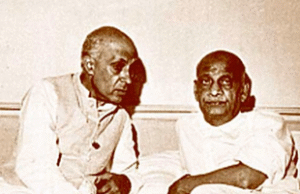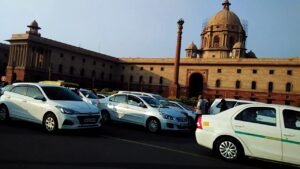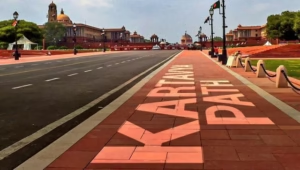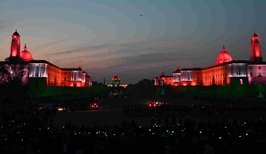Will Seat of Power on Raisina Hills fade into Kartavya Path crowds?
As South-North Block buildings have been synonymous with grandeur and Power since August 1947, a Fort of World’s Largest Democracy; been witness to many defining moments, the move to shift downwards is fraught with anxiety in the minds of common Citizens
New Delhi: As Independence approached in August 1947, the lights in the Herbert Baker–designed South and North Blocks burned late into the night. Prime Minister Pandit Jawaharlal Nehru worked with his staff ar ound the clock in his South Block office to finalise the process of independence and partition, while Home Minister Sardar Vallabhbhai Patel laboured in North Block to ensure the smooth integration of more than 562 princely states into the Indian Union.
ound the clock in his South Block office to finalise the process of independence and partition, while Home Minister Sardar Vallabhbhai Patel laboured in North Block to ensure the smooth integration of more than 562 princely states into the Indian Union.
In their celebrated book Freedom at Midnight, Larry Collins and Dominique Lapierre captured the intensity of those days within the two Secretariat buildings.
Shifting out of Raisina Hill: Situated on Raisina Hill, the North and South Blocks have been pivotal to India’s governance since their completion in 1931. They have housed the administrative nerve centres of the government, symbolising authority and continuity from the colonial to the independent eras.
Now, both buildings will soon be vacated. The Prime Minister’s Office is expected to shift from South Block to the newly constructed Executive Enclave-I, located just a few hundred metres away, by September 2025. The Ministry of Home Affairs and the Ministry of Personnel have nearly completed their move to Kartavya Bhawan-3, inaugurated by Prime Minister Narendra Modi earlier this month.
“The North and South Blocks have remained central to India’s governance due to their role as the administrative heart of the nation,” said noted journalist Trilokdeep, who often visited the buildings in his reporting years.
He explained that South Block houses the Prime Minister’s Office, the Ministry of Defence, and the Ministry of External Affairs, while North Block accommodates the Ministries of Home Affairs and Finance. These institutions oversee critical aspects of governance, from internal security to economic planning, making the structures
 indispensable.Nerve centre in times of war: Old-timers recall that during the 1971 war against Pakistan, South Block became the nation’s war hub. A ‘War Room’ was set up where the entire strategy and monitoring were conducted.
indispensable.Nerve centre in times of war: Old-timers recall that during the 1971 war against Pakistan, South Block became the nation’s war hub. A ‘War Room’ was set up where the entire strategy and monitoring were conducted.
It was here that Prime Minister Indira Gandhi held crucial meetings with Field Marshal Sam Manekshaw and senior military officials. Gandhi’s resolute leadership and Manekshaw’s candid military advice echoed in its rooms, as every order and every report of victory first reached this War Room.
Even during the recent Operation Sindoor, Prime Minster Narendra Modi met the top brass of the defence forces, Defence Minister, NSA, and undertook vital decesions in his South Block office.

Lutyens accused Baker of sabotaging his design, bitterly referring to the episode as his “Bakerloo”—a pun on Baker’s name and London’s Bakerloo line. Baker, however, defended the gradient on practical and aesthetic grounds, and historical records suggest that Lutyens had initially approved the plans.
Witness to history: Built originally to house the British bureaucracy after the Capital shifted from Calcutta to Delhi in 1911, the two blocks seamlessly transitioned into the seat of power for independent India in 1947.
The annual Beating Retreat ceremony at Vijay Chowk, held between them, further underlines their cultural and national importance. Under the Central Vista redevelopment plan, the buildings are set to be repurposed as museums by the end of 2025.

Sanjaya Baru, in The Accidental Prime Minister, recalled how in 1991, amid a severe economic crisis, Prime Minister PV Narasimha Rao and Finance Minister Manmohan Singh crafted a historic budget in North Block. Great secrecy surrounded the process, and when Singh concluded his speech in Parliament, he quoted Victor Hugo: “No power on earth can stop an idea whose time has come.”
Architectural grandeur: The construction of the Secretariat buildings was completed in 1929 at a cost of Rs 17.5 million. Contracts were awarded to multiple builders, including Sir Sobha Singh.
Each block, four storeys high with about 1,000 rooms, was built using cream and red Dholpur sandstone—the red forming the base and cream adorning the walls and domes. The architecture blends classical European designs with Indian elements such as Mughal-inspired gateways, jaali, chajjas, and chhatris. Lotus and elephant motifs further highlight Rajputana and Mughal influences, adapted to India’s climate.
Monkeys and ministries: For decades, employees have shared the North and South Blocks with a persistent nuisance: monkeys. They are known to snatch food and even run off with files.
Authorities tried various measures. At one point, langurs were brought in to scare them away. When this was stopped over animal rights concerns, staff were hired to mimic langur calls to drive the monkeys out.
Ultimately, the North and South Blocks are not just structures of stone and brick. They are silent witnesses to India’s triumphs and trials, from independence to war, economic transformation, and everyday governance. (pic credit-google.com).
——————————————————
*Veteran Journalist and Author, Vivek Shukla. has a knack for uneart hing hidden history of Delhi and metamorphosis of the city from ancient Mahabharata era into New Delhi, the seat of power of world’s largest democracy.
hing hidden history of Delhi and metamorphosis of the city from ancient Mahabharata era into New Delhi, the seat of power of world’s largest democracy.
Mr. Shukla is the author of best selling titles Gandhi’s Delhi and The Story of Emergency, 1975. His daily columns are keenly awaited by lacs of his readers thru’ a national daily and social media.

Comments are closed.